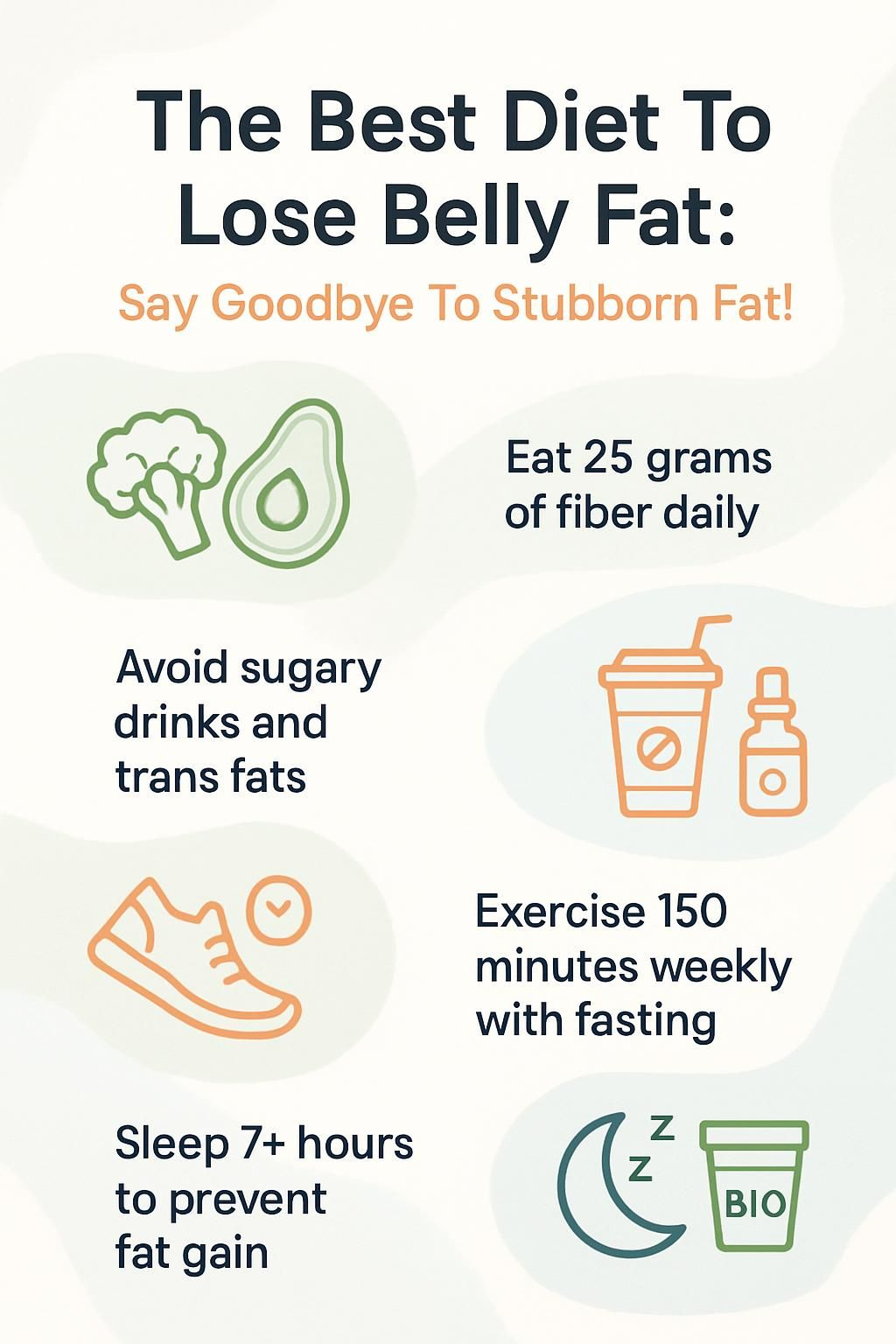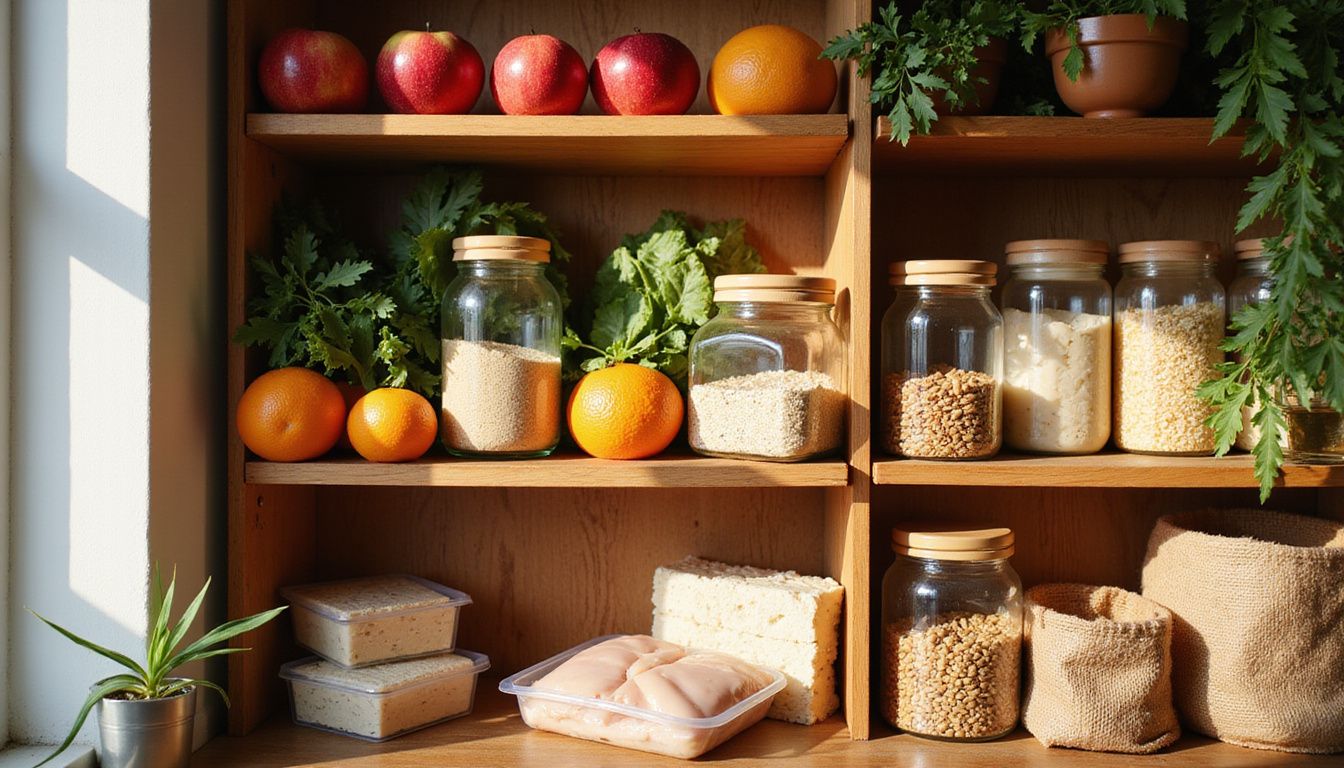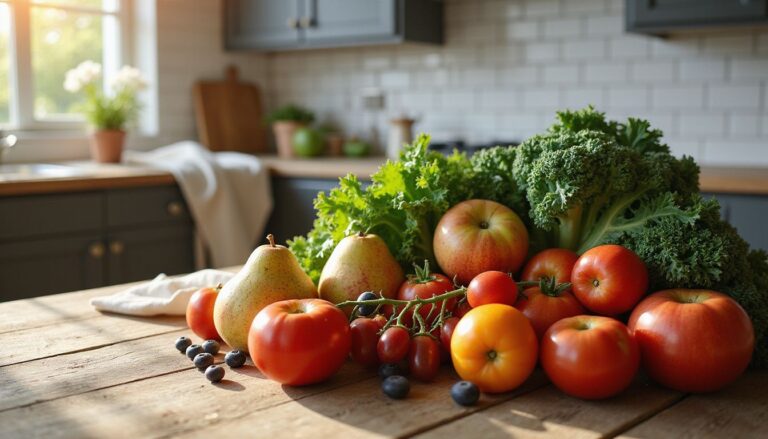The Best Diet To Lose Belly Fat: Say Goodbye To Stubborn Fat!
Our Nutrition Assistant AI Suite will transform your body. You will lose fat, get toned, and build muscle. Gain confidence and optimal health.
Trying to lose belly fat can feel frustrating. Extra fat around your middle raises the risk of type 2 diabetes, heart disease, and obesity. A smart diet, steady habits, and a simple plan help you lose weight and protect your health.
This guide shows you what works. You will learn how to eat for a calorie deficit, choose foods that fight visceral fat, and build habits that last. You will also see how exercise, sleep, and stress control shape your results.
If you want clear steps that help you reduce body fat faster, keep going.
This content is educational and not medical advice. Talk with your healthcare provider if you have a condition or take medication.
Key Takeaways
- Eating at least 25 grams of fiber daily links to less belly fat, with studies showing about a 3.7% drop over five years.
- Cut sugary drinks, refined carbs, and trans fats. Choose whole foods, lean proteins, and healthy fats to lower visceral fat tied to diabetes and heart disease.
- Intermittent fasting, such as the 16:8 method, plus 150 minutes a week of aerobic exercise can shrink your waist based on recent research.
- Getting seven or more hours of quality sleep is tied to less weight gain around the abdomen in large, long-term studies.
- Probiotic foods, like yogurt and kefir, have reduced visceral fat in clinical trials when eaten daily for about twelve weeks.

Understanding Belly Fat

Belly fat includes two types, visceral fat and subcutaneous fat. Subcutaneous fat sits under your skin. Visceral fat wraps deeper around your organs in the abdomen. Too much of either can be a problem, but visceral fat carries higher health risk.
What is belly fat?
Subcutaneous fat is the soft layer you can pinch on your belly or thighs. Visceral fat sits behind that layer and surrounds your liver, kidneys, and intestines. Think of visceral fat as padding you cannot see, but it still affects your health.
Doctors see excess visceral fat as more dangerous. It raises the odds of type 2 diabetes and heart disease. For many women, a waistline over 35 inches, about 89 cm, signals higher risk. Hormone changes with age or menopause often shift where you store fat, pushing more fat to the midsection.
If your pants feel tighter even when weight stays the same, you might be losing muscle and gaining visceral fat. A simple tape measure can reveal changes before the scale does.
“The higher percentage of visceral fat a person has, the greater their risk for metabolic syndrome.”
What are the differences between subcutaneous and visceral fat?
Subcutaneous fat sits right under the skin. You can see it and pinch it. It stores energy and helps with temperature control. Visceral fat hides inside the abdomen and wraps around organs like the liver and pancreas, so you cannot pinch it.
High visceral fat connects to insulin resistance, inflammation, heart disease, and some cancers. Waist circumference is a quick way to estimate how much you carry. While both types store extra calories as fatty acids, visceral fat more often harms blood vessels and major organs.
The Importance of Losing Belly Fat
Losing belly fat improves your metabolic health and lowers disease risk. Even modest loss around the waist can improve blood sugar and blood pressure.
What health risks are linked to excess belly fat?
Too much belly fat, especially visceral fat, raises your risk for type 2 diabetes, heart disease, high blood pressure, stroke, fatty liver disease, sleep apnea, and certain cancers. Research ties large amounts of visceral fat to a higher risk of early death.
Body mass index, BMI, does not show fat distribution. Measuring your waist can spot unhealthy fat sooner. Tracking your waist while you work on nutrition and activity gives faster feedback than the scale alone.
How does losing belly fat improve health?
Reducing belly fat lowers inflammation and helps your body use insulin more effectively. That means steadier blood sugar and better energy. People who combine aerobic exercise with strength training see the biggest drops in intra-abdominal fat.
Less abdominal fat also lightens the workload on your heart and blood vessels. Many people notice less bloating, better energy, and improved lab results within a few months of balanced eating and regular movement.
Key Principles of a Belly Fat Loss Diet
A healthy diet is the foundation for losing fat, especially around the abdomen. Small daily choices add up to steady progress.
How does maintaining a calorie deficit help lose belly fat?
A calorie deficit means you eat fewer calories than you burn. Your body then uses stored fat, including belly fat, for energy. Tracking what you eat with a simple app or food journal helps most people stay consistent.
Cutting one sugary drink can trim 100 to 200 calories a day. Keep your deficit moderate, then give it time. Consistent, small deficits beat extreme diets that are hard to maintain.
Why focus on nutrient-dense foods for belly fat loss?
Nutrient-dense foods deliver vitamins, minerals, and fiber without many extra calories. Choose fruits, vegetables, whole grains, lean proteins like fish or yogurt, and healthy fats such as olive oil and nuts. These foods help you feel full on fewer calories.
Patterns like the Mediterranean diet, which is rich in monounsaturated fat from olive oil, avocados, and nuts, support smaller waistlines and heart health. High-fiber foods steady blood sugar and reduce hunger. Yogurt intake has been linked with less belly fat in some studies.
Foods to Include in Your Diet
The right foods help you feel full, protect muscle, and reduce fat storage around your waistline.
Which high-fiber foods support belly fat loss?
Soluble fiber forms a gel in your gut, slows digestion, and boosts fullness. In a study of more than 1,100 adults, each extra 10 grams of soluble fiber per day linked to a 3.7 percent drop in belly fat over five years.
- Great sources: oats, barley, beans, lentils, apples, oranges, carrots, broccoli, Brussels sprouts.
- Simple win: start meals with vegetables or soup to fill up with fewer calories.
- Smart snacks: raw nuts or fruit between meals to keep hunger in check.
What are the best lean protein sources for fat loss?
Lean proteins help you stay full and protect muscle mass during weight loss. Losing muscle slows metabolism, so protecting it matters.
- Animal options: chicken breast, turkey, lean beef, fish like salmon or cod, eggs, low-fat Greek yogurt, cottage cheese.
- Plant options: beans, lentils, tofu, tempeh, edamame.
- Use whey or plant protein shakes for quick meals or after resistance training.
Higher protein diets, around 25 to 30 percent of calories, are linked with less belly fat gain over time.
Which healthy fats help reduce belly fat?
Healthy fats support fullness and heart health. Fatty fish provides omega-3s, which may help reduce visceral fat in some people.
- Eat salmon, sardines, mackerel, anchovies, or herring two to three times per week.
- Use extra virgin olive oil, and add avocado, nuts, and seeds to meals.
- Consider algae-based omega-3 supplements if you do not eat fish. Ask your clinician first.
Swapping processed snacks for a small handful of unsalted nuts can reduce afternoon cravings and support a smaller waistline.
How do probiotic-rich foods aid belly fat loss?
Probiotics are helpful bacteria that support gut health. A healthier gut may reduce inflammation and improve digestion, which can support fat loss.
- Good choices: yogurt, kefir, kimchi, sauerkraut, miso, tempeh.
- Some strains, like Lactobacillus fermentum, amylovorus, and gasseri, have reduced visceral fat in small trials.
Supplements may help, but talk with your healthcare provider before starting any new product.
Can green tea and herbal teas help burn belly fat?
Green tea contains caffeine and EGCG, a plant compound that can slightly boost calorie burn. Reviews suggest that regular green tea intake for at least 12 weeks can lead to small reductions in weight and waist size.
Simple swaps work well. Replace soda or sweet tea with unsweetened green tea or herbal tea. Many people notice less bloating and fewer cravings after a few weeks.
Foods to Avoid or Limit
Some foods push your calorie intake up fast and make fat loss harder. Trimming these improves your odds.
Why avoid sugary beverages and snacks?
Sugary drinks like soda, punch, sweet tea, and many mixers pack lots of sugar. An 8 ounce glass of unsweetened apple juice has about 24 grams of sugar, much of it fructose. Liquid calories do not fill you up, so it is easy to overdrink them.
High sugar intake links to weight gain and more belly fat. If you want to lose belly fat, limit sugary drinks and desserts. Choose water, sparkling water, unsweetened tea, or coffee instead.
How do processed and refined carbs affect belly fat?
Refined carbs, such as white bread, pastries, and many snacks, spike blood sugar and insulin. High insulin encourages fat storage around the waist. People who eat more whole grains are less likely to carry excess belly fat than those who rely on refined grains.
Switch to unprocessed starchy carbs like oats, quinoa, brown rice, and potatoes with the skin. If you have insulin resistance or PCOS, a lower carb pattern often reduces waist size faster.
What are trans fats and why avoid them?
Trans fats form when companies add hydrogen to oils. On labels, they appear as partially hydrogenated oils. They raise inflammation and the risk of heart disease, and they are linked with greater visceral fat.
Avoid packaged baked goods and deep fried fast foods that may contain trans fats. Choosing whole foods and reading labels helps you steer clear of them.
How does excess alcohol impact belly fat?
Alcohol adds extra calories and slows fat burning. Your body burns alcohol first, which delays using fat for energy. Higher alcohol intake is linked with larger waistlines in population studies.
Limit drinking to the Dietary Guidelines, up to two drinks a day for men and one for women. Swapping cocktails for sparkling water with citrus is a simple step many people find helpful.
Effective Eating Habits
How you eat is as important as what you eat. A few simple habits can change your results.
How can portion control help reduce belly fat?
Portion control helps you create a calorie deficit without counting every bite. Use smaller plates, measure servings, and log food for a week to learn your patterns.
Cutting large pours of oils, nut butters, and dressings often saves hundreds of calories per day. Start with one habit you can repeat, then build from there.
Why eat smaller, frequent meals to lose belly fat?
Smaller, frequent meals can steady hunger and energy. Eating every three to four hours reduces the chance of overeating at night. Focus each mini meal on protein and fiber.
- Start meals with vegetables or a broth-based soup.
- Choose whole fruit over juice to get fiber and fewer calories.
- Prepare protein-rich snacks like Greek yogurt or hummus.
This rhythm helps many people, especially women in midlife, manage appetite as metabolism changes.
How important is staying hydrated during fat loss?
Water supports digestion and helps control appetite. Replacing sugary drinks with water trims daily calories, which supports a smaller waistline.
Try sipping cold sparkling water with lemon between meals. Many people snack less and feel better hydrated, which supports steady energy during the day.
Additional Tips to Boost Results
Small lifestyle upgrades often unlock progress when your plan feels stuck.
What is intermittent fasting and how does it help belly fat loss?
Intermittent fasting sets daily eating windows, such as 16 hours fasted and 8 hours eating. This approach can reduce calories without strict counting. During fasting hours, your body turns to stored fat for energy.
Pair time-restricted eating with adequate protein to protect muscle. Some people, especially postmenopausal women or those with diabetes, should monitor blood sugar closely and consult a clinician before starting.
How does regular exercise complement a belly fat loss diet?
Aerobic exercise, like brisk walking, cycling, or swimming, helps you burn more calories. Aim for at least 150 minutes per week of moderate activity, or 75 minutes of vigorous activity.
Strength training matters too. Lifting weights two to three days per week helps you keep muscle, which supports a higher metabolism. High-intensity interval training, HIIT, can also reduce waist size efficiently for many people.
What are effective stress management techniques for fat loss?
High stress raises cortisol, a hormone that can increase belly fat storage. Short daily sessions of yoga, meditation, or deep breathing lower cortisol and improve appetite control.
Try a 10-minute walk outside, or set a two-minute breathing break between tasks. Managing stress supports better sleep and more consistent food choices.
Why is quality sleep important for losing belly fat?
Sleeping seven or more hours supports hormones that regulate hunger and metabolism. Large studies show that people who sleep less than five hours a night gain more weight over time, including around the waist.
If you snore or wake unrefreshed, ask your clinician about sleep apnea. Treating sleep problems often makes weight loss easier.
Sample 7-Day Meal Plan for Belly Fat Loss
Use this flexible plan as a template. Adjust portions to your calorie needs and activity level.
What does a balanced breakfast, lean protein lunch, and light dinner look like on Day 1?
Breakfast: oatmeal with berries, chia seeds, and a small handful of nuts. Choose water or unsweetened green tea.
Lunch: grilled chicken breast or baked fish with quinoa and steamed broccoli.
Dinner: large spinach salad with chickpeas, cherry tomatoes, cucumbers, olive oil, and sliced avocado.
This day balances fiber and protein to control hunger and protect muscle mass.
How to include high-fiber snacks and protein-packed meals on Day 2?
High-fiber snacks: apple slices with peanut butter, carrot sticks with hummus, or mixed berries.
Meals: eggs or Greek yogurt at breakfast, then grilled fish, roasted chicken, or bean chili later. Aim for at least 25 grams of fiber across the day, and keep a modest calorie deficit using a food journal.
How to incorporate healthy fats and probiotics on Day 3?
Breakfast: Greek yogurt with walnuts and chia seeds. Lunch: leafy greens topped with salmon or mackerel, avocado, and extra virgin olive oil.
Snacks: kimchi or sauerkraut for probiotics, and whole grain crackers with hummus. Dinner: roasted vegetables in olive oil with lean chicken or tofu.
Sample Nutritional Content Table:
| Food Item | Healthy Fats (g) | Probiotics Present? |
|---|---|---|
| Greek yogurt | 0 to 8 | Yes |
| Walnuts, 1 ounce | 18 | No |
| Salmon, 4 ounces | 9 | No |
| Olive oil, 1 tablespoon | 14 | No |
| Kimchi or fermented vegetables | Less than 1 | Yes |
Evidence note: Mediterranean-style eating patterns with olive oil are linked with smaller waistlines in several reviews, including Harvard public health summaries updated in 2022.
What are some low-carb dinner options for Day 4?
Try grilled chicken with roasted broccoli and cauliflower. Add a drizzle of olive oil for flavor and fullness. Another option is baked salmon with asparagus and sliced avocado.
Skip bread and pasta at dinner. Build your plate around vegetables and protein to keep carbs and calories lower at night.
How to focus on plant-based meals on Day 5?
Lean on beans, lentils, tofu, and whole grains. Make a lentil and veggie bowl with quinoa for lunch. Add colorful vegetables like spinach, carrots, peppers, and broccoli.
For healthy fats, use nuts, seeds, and olive oil. Many people notice steadier energy and better digestion on plant-forward days due to higher fiber.
What does a hydration-focused day with green tea look like on Day 6?
Start with green tea for a light metabolism boost. Sip water, unsweetened iced tea, or sparkling water with lemon all day.
Eat water-rich foods such as cucumber, lettuce, tomatoes, and watermelon. Avoid juice and sweet drinks to keep your calorie deficit on track.
How to enjoy a variety of nutrient-dense meals on Day 7?
Breakfast: Greek yogurt, berries, and a sprinkle of nuts or seeds. Lunch: grilled chicken or beans over a mixed salad with quinoa.
Dinner: fish with roasted Brussels sprouts and sweet potato. Add a small serving of kimchi or sauerkraut for probiotics. Snack on fruit with nut butter, or veggie sticks with hummus.
Common FAQs
Here are quick answers to common questions about reducing belly fat.
What foods burn belly fat the fastest?
High soluble fiber foods help most. Oats, beans, apples, and berries are top picks. Lean proteins like eggs, Greek yogurt, chicken, and fish increase satiety and slightly raise calorie burn during digestion.
Fatty fish provide omega-3s that may reduce visceral fat. Probiotic foods, such as yogurt with Lactobacillus strains, can support healthy weight. Green tea adds a small thermogenic effect when used daily.
Can I lose belly fat in one week?
Fast belly fat loss in a week is not realistic. Safe fat loss is usually 1 to 2 pounds per week, which comes from overall body fat, not one spot. Extreme low-calorie plans mostly drop water, then stall.
Skip products that claim to melt belly fat. Build steady habits instead. If you have a medical condition, work with your clinician for a safe plan.
Is exercise essential for losing belly fat?
You cannot spot reduce with crunches. To lose belly fat, reduce overall body fat with a calorie deficit and regular activity. Aim for at least 150 minutes per week of moderate aerobic exercise.
Add strength training two to three times weekly. More muscle helps you burn more calories at rest, which supports a smaller waistline.
Conclusion
A focused diet and steady habits help you lose belly fat and protect your health. Build meals from fiber-rich plants, lean protein, and healthy fats, then limit sugary drinks and refined carbs. Keep a modest calorie deficit, move your body most days, and manage stress and sleep.
Small choices add up. With patience and a clear plan, you can reduce visceral fat, support a healthy weight, and feel better day to day.
FAQs
1. What foods should I eat to lose belly fat effectively?
Eating more nuts, such as almonds and walnuts, can help reduce belly fat because they provide healthy fats and protein. Studies show that people who include nuts in their diet tend to have less abdominal fat compared to those who do not. Nuts also keep you full longer, which helps control calorie intake.
2. How does exercise like crunches help target stubborn belly fat?
Crunch exercises strengthen the muscles in your abdomen but do not directly burn the fat covering them. Research shows that while crunches improve muscle tone, a combination of aerobic activity and strength training is most effective for reducing overall body and belly fat.
3. Can alcohol affect my ability to lose belly fat?
Long-term effects of alcohol use may increase the storage of abdominal fat by changing how cells process nutrients. Data from several studies indicate that heavy drinking leads to higher levels of visceral adipose tissue around internal organs compared with moderate or no alcohol consumption.
4. Why is understanding cell biology important for losing belly fat?
Understanding cell biology helps explain how your body stores and burns energy at the cellular level. Fat loss occurs when cells break down stored triglycerides for fuel during calorie deficits created through diet or exercise routines like crunches combined with eating nutrient-rich foods such as nuts.
Summary: Eating nutrient-dense foods like nuts supports weight management by promoting fullness and providing essential nutrients; combining these choices with regular physical activity targets both muscle development and overall body composition changes needed for lasting results in reducing stubborn abdominal areas.
Sources: Harvard T.H. Chan School of Public Health; American Journal of Clinical Nutrition







